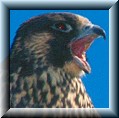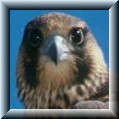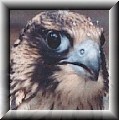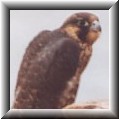As of Thursday, July 19th we still have no
confirmed kills. We are only able to observe the falcons for three to four
hours per day, so we can't be sure of what they're up to when we're not around.
However we haven't found any carcasses and the birds seem very hunger when we
arrive daily for feedings. The quality of their pursuits is definitely
improving though, so it's just a matter of time.
Sunday July 15, 2001
Ross Struthers reports: Today marks the end of our volunteer
falcon watch. Thank you to all those generous people who donated their
time to baby-sit our birds. I will continue to observe the birds for short
periods each day and post periodic updates on their progress.
Now that I finally have time to catch-up with some administrative duties, here
are the winners of the "Name That Chick" contest.
Marg Mannseichner
Kate Price
Courtney Laidler
Congratulations to our winners. Marg and
Kate will receive "Leeds Peregrine Project" T-shirts, and Courtney has
been awarded a cash prize from the Brockville Recorder & Times.
Today was a beautiful sunny day. The kind of day that all of our birds
decided to enjoy by sitting in the shade of near by trees and moving as little
as possible. Full crops and high temperature make for lazy Peregrines.
Why fly when you can digest?
Not all of Charleston Lake's residents are thrilled about the arrival of the
falcons. Tree swallows have been observed harassing the falcons on several
occasions. The falcons seem genuinely annoyed by this harsh treatment and
will often relocate to another tree. It's rather amusing to see an
infamous raptor chased from his perch by some very small, but brave swallows.
Saturday July 14, 2001
Ross Struthers reports: Today is
Ruby's second day wearing the transmitter. In no way has it affected her
flight or behavior. She doesn't even seem to notice. In fact it's
actually very difficult for our observers to see, even with binoculars.
Ruby has preened her feathers, so that the harness and transmitter box are
completely hidden. The only sign of the transmitter is a six inch antenna
sticking out of her back.
The birds are extending the range of their flights. Although they spend
most of their time within sight of the hack box, they are beginning to fly
beyond the range of our observers. It's quite common for Webster to
disappear for most of the day, apparently preferring his own company to that of
others. Despite Webster being 1/3 smaller than the others, he has a
voracious appetite. He has been observed eating several times a day, and
continues to feed even when his distended crop looks like it's beyond full
capacity. He is often the most active of the falcons, so I guess he needs
the extra energy.
Today saw another pursuit by the falcons. This time is was a gull that was
the hapless victim. One of the falcons, who was not identified, pursued
the gull from the hack all the way around the nearest island and out of sight.
We did not observe any contact between the birds, and it is impossible to
determine if the pursuit was motivated by territoriality or predatory instinct.
Friday July 13, 2001
Marcel Gahbauer reports: Today marked
another important milestone for the Leeds site - the local launch of Project
Track-'em, to study the movements of Ruby over the next 10 to 12 months via
satellite telemetry.
Ruby had been caught in the hack box yesterday,
and spent the night resting comfortably in the dark. She proved to be a
strong but remarkably relaxed bird during the attachment of the transmitter.
Mark Nash held Ruby while I attached the transmitter and its backpack harness.
Thanks to Pud Hunter for attending to provide his advice, to the Struthers
family for hosting the event, to Gary Nielsen for being the all-important
"third pair of hands", and to Franziska von Rosen and Garnet Baker for
documenting the entire process on film.
Within an hour, Ruby was wearing her new
transmitter and was ready for release. We carried her back to the hack
box, only to find the other three peregrines perched on it as if awaiting her
return! Charlie and Webster were on the roof, while Athena was on the
front platform. They all flew off as we came closer, but did not go too
far. Ruby was placed back inside, and no sooner had the trap door on the
front been raised, than she shot out and flew over the lake, soon to be joined
in the air by one of her siblings.
At the same time that Ruby was released, four
quail were left on the platform of the hack box to feed the peregrines for the
day. Less than half an hour later, Ruby was the first of the peregrines to
return for a meal. She quickly ripped into one quail with her beak, while
greedily grabbing a second one with her right foot and tucking it under her.
Webster arrived a couple of minutes later, but found that his sister was not in
a sharing mood, and quickly grabbed a quail and flew off down the cliff with it.
Charlie was next to visit, and also didn't linger for long, but went into the
box with a quail instead of leaving altogether. Finally Athena flew in,
and of course no quail was free for the taking by that time. Instead, she
had to struggle to pry some food away from Ruby, who was not at all happy with
this idea. Some considerable struggles ensued, with dramatic tug-of-war
battles and lots of shoulder-to-shoulder shoving. Eventually Ruby had
gorged herself enough that she relented a bit, and Athena got a good feed too.
A few minutes later, the peregrines left the box again, one by one to take up
positions on various points along the cliff.
Reports on all of the Charleston Lake birds will
continue to be reported on this page. However, a separate page has been
created to document Ruby's
travels, and she also has a new photo
gallery of her own. All reports from her satellite transmitter
will be posted in this new section.
Thursday July 12, 2001
Ross Struthers reports: Yesterday was
a very slow day, with no developments worth reporting.
Today saw phase one of our involvement in "Project
Track-'em" put into action. This is part of the Canadian
Peregrine Foundation's efforts to track the migration and movement of falcons
using satellite transmitters. The first step involved capturing one of our
birds. A trap is an integral design feature of our hack box, but it only
works if the birds cooperate and go inside. Since they are spending so
little time in the box, we anticipated some difficulty. We placed some
food in the box and one of our observers waited patiently between the double
doors of the hack, ready to trigger the trap when alerted to the presence of a
bird by our observers below. Ruby cooperated almost instantly and was
successfully captured. She's now spending the night incarcerated in bird
jail. She's resting comfortably and seems pretty happy, since she has been
fed and watered. Tomorrow Mark Nash, president of the CPF, Marcel Gahbauer,
CPF biologist, and Pud Hunter of the MNR will be on hand to fit Ruby with a
satellite transmitter. She will be release again at approximately 11:00am.
Our birds passed two important developmental milestones today. Early this
morning an osprey flew directly over the hack. On previous occasions the
birds had vocalized at him, but his time they chased him down. A dog fight
ensued, involving all three falcons and one very surprised Osprey. A very
unlucky and unobservant Great Blue Heron flew right threw the middle of this
melee. It was like watching a pack of fighter jets duking it out, with a
747 thrown in just to complicate things. The falcons ignored the heron and
stayed on the osprey. No contact was made, but the osprey got the message
that he was unwelcome in the falcons' territory. He beat a hasty retreat.
Milestone number two also involved a pursuit. This one wasn't territorial
thought. The falcons are starting to realize that some of the birds flying
by the nest look rather tasty. Shortly after the osprey incident, all
three birds made a brief and half-hearted pursuit of a kingbird. He
escaped easily, but what is important is that the falcons have made the
connection between what the food we've essentially been spoon feeding them, and
the local selection of airborne delicacies. I don't think it will be long
before I'll be reporting their first kill.
Tuesday July 10, 2001
Ross Struthers reports: The falcons
continue to make fantastic progress. All the flying they've been doing has
greatly increased their strength and endurance. Webster continues to improve
upon the length of his flights. He is now exceeding a
minute. That may not sound like much, but only a few days ago a
"long" flight was 10 seconds.
The birds are still just beginning to experience
the world around them. Today they weathered their first thunderstorm. Unfortunately
we had to take cover, so we didn't get to see how they reacted to thunder and
lightening. However when we returned after the storm we found all the
birds outside of the hack looking pretty soaked. I don't think they
enjoyed the experience.
After they dried their feathers it was back to
the school of flight. Everyone seems to have mastered soaring and quick
turns. In between flights, an osprey with a fish in its talons flew
directly over the hack. All of the falcons let him know he was not welcome
by screeching a warning that could have shattered glass. No one felt
brave enough to pursue him though. I guess they're all talk...for
now.
Athena, Ruby and Webster are beginning to have
mock battles. If one of them flies off of the hack another is often
quick to follow. Webster is frequently the pursuer. He
over takes the lead bird and tries to make contact...usually succeeding. Webster
used be the Top Gun but Ruby is providing some fierce competition, and
Athena isn't far behind either. It's getting tougher to say who's outdoing
who. And then there's Charles. Despite the fact that Charles still
likes to go for a stroll now and then, he shocked all of us today by making the
longest flight to date, well over a full minute...maybe two. Unbelievable.
I guess he's not a runt after all...just a late bloomer.
Monday July 9, 2001
Ross Struthers reports: The action was
a little leaner today than Sunday. The birds had a big meal this morning,
and they were quite content to stay put on the box and concentrate on digestion.
Today was also quite sunny and warm, so the birds tried to stay cool during the
midday heat by spending lots of time underneath the hack, in the shade.
We observed a very interesting maternal
display by Ruby. She flew off the hack carrying some food, and
delivered it to Charles. Ruby seems to have noticed that
Charles is the runt of the litter, and is trying to help him out. Charles
seemed appreciative and pretty happy to chomp down Ruby's delivery.
After a snack and a rest Charles did a little flying, but took lengthy
rests in between. He also spent nearly more time walking than
flying, but he's improving.
Although flights were less frequent today, a few
of them were very impressive. Webster decided that just flying isn't challenging
enough anymore, so he has upped the ante by giving chase to
Athena during her flights. He even made mid air contact a few times.
Ruby surprised everyone by putting on the most stunning and spectacular flight
to date. So far Webster has been the strongest flyer, but Ruby
showed him up today with an aerial display that included soaring, fast turns, loops,
and an impressive amount of speed. But Webster clearly can't stand
being out done, so he not only chased Athena, but he flew underneath her INVERTED!
He attempted to lock talons but didn't manage to make contact. He had
radio's buzzing and left stunned expressions on the faces of our volunteers.
I can't wait to see what he can manage tomorrow.
Sunday July 8, 2001
Ross Struthers reports: Today was even
more exciting than yesterday. The falcons were all up early. Athena,
Ruby and Charles were on the roof on the hack box at 5:30am stretching their
wings. Athena and Ruby's first flight was a short one. They wisely
decided not to head straight off the cliff. Instead they made a very short
hop towards the treeline, landing about three meters from the box. Three
meters isn't much but it still counts as a flight. "Just like the
Wright brothers" a volunteer exclaimed over the radio.
Athena's next flight was a little more daring.
She managed to gain some altitude and landed in a pine tree on top of the cliff.
Just about this time Webster returned from his overnighter in a tree. Ruby
soon followed Athena's example and made her first real flight. Charles
watched all this action from the hack box showing no interest in airborne
adventures. So began a successful day of flying for Athena, Ruby and
Webster.
Webster spent a lot of time showing off. Having had an
extra day of practice, his aerial skills far exceeded the rest. He put on
some spectacular displays looping and soaring on extended flights. Charles
remained firmly planted on the box all this time, apparently trying to decide if
he was a falcon or a turkey. Finally at noon he made a short flight to
join the other birds on a grass covered section of the cliff. After his
three siblings returned to the box Charles was left behind. Not feeling up
to another flight he walked all the way back to the hack box, confirming our
suspicions that he is clearly having not only a sexual identity crisis (we
suspect he is actually a she) but also a species identity crisis, believing that
he might be an ostrich or a turkey.
Despite Webster's impressive flying ability he hadn't quite
mastered that tricky landing part. He circle the hack box repeatedly,
making several aborted landing attempts before he finally got it right.
All the birds, including Charles, spent the rest of the day making progressively
longer flights. There were a few hard landings, but nothing was injured
except some avian pride. By afternoon, flight was becoming more like an
accepted ability than a frightening revelation. The landings got
significantly softer too. It was truly amazing how fast the birds
improved. They are all quite capable of short controlled flights and can
land on the hack box every time.
Our volunteers had their hands full trying to keep track of
four birds at once. Conditions briefly approached chaos, but like the
birds, we learned quickly too. By the end of the day not only could we
track the birds continuously, we could also identify them with ease.
Thanks to a camouflaged blind near the hack box and a spotting scope, we are
even able to read the birds band numbers. Considering this is our first
attempt at hacking, everything is going extremely well. A big thanks to
the staff of the Canadian Peregrine Foundation for showing us the ropes and
getting us started.
Saturday July 7, 2001
Ross Struthers reports: Our chicks now
have names! Thanks to everyone who contributed and congratulations to our
winners. Several people suggested the same winning names, but
unfortunately we have a limited number of prizes. Therefore two winners
will be chosen at random from a list of finalists.
Bird Names:
Athena (large female) - Athena is the Greek goddess of wisdom, and for
the near by village of Athens.
Ruby (female) - after cliff the chicks call home, Rube's Rocks
Charles (originally identified as a male, but could be a female) - after
Charleston Lake of course
Webster (small male) - Webster's Bay is located directly north of Rube's
Rocks
And now for the news. Today was release day! After having a three
pigeon breakfast, the bars at the front of the hack box were removed at 6:48am.
At first no one approached the door. The birds seemed a little confused by
their new found freedom. Athena was the first to emerge, which is not
surprising considering her dominant, aggressive behaviour over the last 2 weeks.
By 7:45am, an hour after the hack box was opened, all the birds had emerged onto
the deck at the front of the box. Most of the next hour consisted of a lot
of wing stretching and flapping, but no one flew farther than the roof of the
hack box. At 8:45am Webster decided it was time to take to the air.
He made a short trip along the cliff and landed in a tree. During the rest
of the day he made a couple more flights along the cliff from tree to tree.
He did not return to the hack box, and instead choose to spend the night in a
tree. None of the other birds attempted a flight. They did lots of
flapping, but seemed content to just perch on the deck of the hack box. We
are all grateful that Webster had a successful flight and that there were no
injuries. We expect to see more action from the remaining birds tomorrow.
Friday July 6, 2001
Ross Struthers reports: The birds had
their first taste of the local cuisine today. So far they have been eating
a steady diet of quail, but today they had grackle and starling. There
was zero hesitation when the new food was dropped into the box.
Tomorrow (Sat. July 7th) is release day. If the weather cooperates the
birds will be released sometime after 5:30am. Let's hope they all have
safe and successful flights.
Wednesday July 4, 2001
Ross Struthers reports: The
chicks continue to make fantastic physical progress. In fact, it almost
seems a misnomer to continue to refer to them as chicks. They are all
looking very much like full developed juveniles. The birds are
also starting to act like adults. A few of them have been observed
pouncing on the quail carcasses, which we have been feeding them. Lately
we often find the carcasses on the inside ledge at the front of the hack
box. This would suggest that one or more of the birds has been flying
the carcasses up there from the bottom of the box. Hopefully the next
update should include the young birds new names, as the "Name That Chick
Contest" is now over. Once names have been chosen the
winners of the contest will be posted on this site. Thank you to everyone
for the creative submissions.
Saturday June 30, 2001
Ross Struthers reports: Today I had
the opportunity to watch a streaming video feed of the chicks feeding. I
was concerned that the larger chicks might be eating the smaller chicks' share
of food. There appeared to be some what of a social hierarchy, based on
size and aggressiveness. The large female stood under the feeding tube, as
soon as she heard it begin to open. The rest of the birds kept their
distance. The large female began to feed instantly, but only fed for a
minute or two before taking a break, and drinking some water. The two
slightly smaller chicks then began feeding, but the smallest male stayed up on
the ledge. Eventually he ate too, but seemed a little hesitant at first.
Everyone appears to be getting their share of food, and no one appeared
particularly gluttonous. As you can see (via the webcam)
we've put two new, large water dishes in the hack box, so the birds will have
plenty to drink and bathe in.
Wednesday June 27, 2001
Ross Struthers reports: The
chicks are starting to get very rambunctious, especially the large female.
It's difficult to see on the webcam, but she is testing her wings inside of the
hack box. She gets lots of exercise bouncing back and forth. Due to
the younger age of the other chicks, they're not as motivated to fly as she is
but they're well on their way. All of the birds are becoming well
feathered now and the large female is looking more like an adult everyday
(except for her immature colouring). The water dish we placed
in the hack box has been emptied every day. We were a bit surprised by
this until we realized that the birds are using the water dish as a bird bath.
It has become their favourite toy. We now have to fill it twice a day just
to keep them entertained. As of yet our chicks are still nameless.
It seems a little impersonal to keep referring to them as "large
female", "small male", etc. Please email
your suggestions so our birds can have identities.
Sunday June 24, 2001
Ross Struthers reports: The
chicks spend most of the daylight hours perched on the ledge at the front of the
box, observing the world beyond and sunning themselves. They act as if
they're conjoined siblings. They're always occupying the same area of the
box at the same time. When they're not on the ledge they're usually
huddled in the back corners of the box, making them difficult to observe on the
web cam. The chicks appear to have voracious appetites. All four
quail they receive at meal time are usually completely devoured by the next day.
Observations during feeding time confirmed that all of them are eating.
The large female gets very vocal when she sees us peering into the box.
She clearly doesn't like having us around.
Saturday June 23, 2001
Marcel Gahbauer reports: It
hasn't taken long for the chicks to explore the full extent of their hack box.
Already this afternoon, I saw on the Charleston
Lake Webcam that at least two of them were on the elevated ledge toward
the front of the box, peering out through the bars at the world beyond.
Friday June 22, 2001
Marcel Gahbauer reports: Today
four young peregrine falcons were delivered to the hack box overlooking
Charleston Lake in Leeds County.
First, however, they were brought to the Athens high school to be banded by
Pud Hunter of the Ontario Ministry of Natural Resources. The chicks were
determined to be two males and two females, all feisty and in good health.
The two males and one of the females are siblings, all 27 or 28 days old, while
the other female is unrelated, and is roughly five days older. There did
not appear to be any confrontation between her and the younger chicks when they
first met; if anything, she seems to have adopted a protective role, placing
herself between the other three and us whenever possible!
The banding was attended by roughly 50 people, including many of the
important sponsors listed at right. Everyone had a wonderful opportunity
to see the birds up close, and several sponsors also had a rare chance to hold
one of the chicks once they had been banded.
By mid-afternoon, we were on the road to the hack site on the north side of
Charleston Lake. While preparing to put the chicks in their new home, we
observed Red-shouldered Hawks, Turkey Vultures, and a family of young Ravens
flying nearby - all of these will no doubt find themselves being harassed by the
young peregrines once they take to the air later this summer.
The chicks were placed in the box, provided with some water for bathing, and
later with their daily meal of quail. They will remain in the hack box for
approximately two weeks, at which time they will be assessed for their readiness
for flight, and released if they are all set to go.
Several photos from the banding and the placement of the chicks in the hack
box have been posted in the Leeds Photo Gallery,
and more are yet to come. Also, live video from a small camera mounted
inside the hack box is now being broadcast to the web - check out the Charleston
Lake Webcam to peek in on the four young peregrines.
Sunday June 17, 2001
Marcel Gahbauer reports: The
Leeds County peregrine chicks are now scheduled to be delivered this coming
Friday, June 22. As previously planned, the peregrines will be banded
before being placed in the hack box, and daily feeding and monitoring will
commence at that time.
Tuesday June 12, 2001
Marcel Gahbauer reports: The
delivery of chicks is being changed once more to accommodate their young age -
their arrival is expected to be delayed by approximately one week; details will
be confirmed as soon as possible.
Friday June 8, 2001
Marcel Gahbauer reports: The
schedule has been adjusted again - the chicks for the Leeds hack will now be
arriving next Thursday, June 14. They will be banded at the time, and
placed in the box above Charleston Lake to acclimatize to their surroundings.
Photos of the hack box and its location have now been posted in the Leeds
Gallery. More information about the birds, as well as photos from the
banding, will be posted following their arrival.
Tuesday May 22, 2001
Marcel Gahbauer reports: Chicks
are expected to arrive for the Leeds County hack site in late June; a precise
date has yet to be set.
Sunday March 25, 2001
Marcel Gahbauer reports: Members
of the Leeds County Stewardship Council have identified a location along the
shore of Charleston Lake for the placement of a hack box, which will be
installed this spring and will be camouflaged to fit in with its surroundings.
We will post updates on this page as the project progresses.











